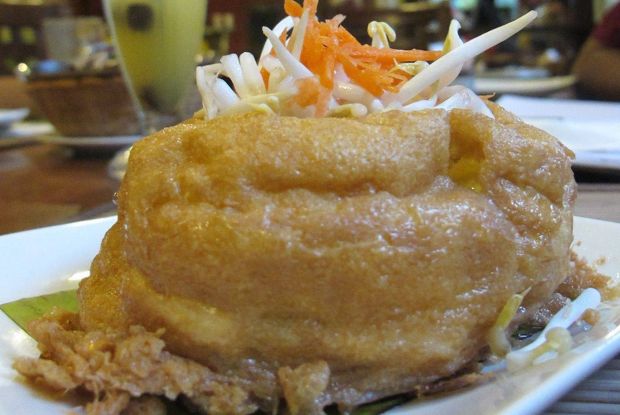A suburban dining room set in a shophouse is where the writer discovers new harmonies in flavourful Malay food.
We arrived at Khadijah’s Kitchen for an early dinner. And a kitchen it certainly is, in the very best tradition.
In fact, it was a little like walking into someone’s kitchen long before the invited guests have arrived, and catching the host unawares in her shabby shorts and tattered T-shirt.
However, here we found one of Malaysia’s most loved songbirds, Khadijah Ibrahim, now Datuk Khadijah, in black, in an ode to her rock chick days.
Lord Restrain, a Brit, had just returned home after a 10-day business trip. And a meal out is always a pleasant way for us to catch up on things. At least that’s what we thought in the early days, until we both kept getting caught — me reading the mag material I cart around with me, and he when he swiftly manoeuvres his (so NOT!) lean and lithe body into a seat that faces the flat-screen.
But distractions were unnecessary with the restaurant owner playing host. She immediately called for Tauhu Telur (RM7.90) and Brick (RM10.50) as starters. I ordered a Calamansi (RM5.50), the Lord “a long’un” (RM5), while our guests both had a Kopi Tarik (RM4.40).
The deep-fried tofu coated with egg was very crispy on the outside, while smoothly soft and succulent inside. The taste and texture were unexpected, the garlic sauce blending with cili padi and lime to add bite for those who prefer it hot, and surprise for the Lord who normally likes it cool.
Naturally, as we talked about the ingredients and spices that distinguish Malay cuisine, the various types of lime came up. In seeking to clear Lord Restrain’s confusion, Khadijah patiently (with a show-and-tell whenever possible) took him through the journey: limau manis, limau nipis, limau kasturi and limau purut.
Meanwhile, I concentrated on consuming the Brick (RM10.50), which is a House signature dish. Wrapped in Tunisian thin-skin, this deep-fried appetiser was packed with tuna, its flavour enhanced with mild cheese and capers. It looked a little oily, although it did not taste so, but perhaps the presentation could have been better.
By contrast, the home-style Kobis Masak Lemak Putih (RM7) accompanied by white rice (RM10) perfectly harmonised and highlighted a very light gravy and a mix of spices, chillies and coconut milk. All adding up to a delightfully mild taste. The assortment of vegetables — tofu, carrots, fu chook and cabbage — were cooked just right, with not a hint of sogginess.
Our lady guest, a vegetarian, enjoyed this thoroughly, along with the Kway Teow Goreng (RM7), fried vegetarian-style. The soft yet firm rice noodles, soaked in sauce and spices, were fried with a light hand and so well harmonised that you don’t even miss the meat or seafood that normally go into this dish.
In small portions served on old-fashioned serving plates, the Ayam Daun Kari (RM8.50) was a lovely surprise. The thick gravy was once again lightly flavoured and delicate, with a lingeringly subtle aroma of curry leaves. Although the pan-fried chicken was a little over-cooked, and thus not as moist as it could be, the gravy more than made up for it.
As the Asam Pedas Ikan Tenggiri (RM9.50) was served, the Lord was subjected to a “kefahaman ikan” test, following his boast of being an old Malaysian hand. “Mackerel,” he announced after a thoughtful chew, once again charming the gullible natives.
Cooked in tamarind sauce, this dish was hot and spicy, all at the same time. The taste was a little too robust for my liking, although the ladies’ fingers in the curry tempered the flavour a little. The Lord’s fingers, however, worked overtime on a second helping of Tenggiri.
Marinated grilled beef in a spicy coconut and tamarind sauce was next, cooked with dried pieces of asam keping, turmeric and daun kunyit. This Daging Salai (RM9.50) was delicious, but by the time it arrived at our table, our tongues began to balk at the full assault. So much flavour and spice, heat and harmony, curry and coconut milk.
Thereafter, the Kerabu Kacang Botor Telur Masin (RM6) was easily the evening’s favourite. The bracing four-angled bean salad came with a zingy mix of salted egg, kaffir leaves, fresh shallots and lime juice. Crisp and crunchy, it was the perfect antidote to all the spicy curries and pedas dishes. At once sour, spicy, sweet and salty, the KKBTM is certainly a dish to savour.
“You have it with halia?” the Lord attempted to show off his impeccable Bahasa, as he weighed the option of ordering a Teh Tarik (RM4.80).
“Worth coming back for,” he pronounced after his first sip, as we Malaysians dug into our favoured Malay desserts.
The Sago Gula Melaka (RM6), was a gala of gooey tapioca pearls swimming in coconut milk and palm sugar, which not too sweetly hung with a lovely after-taste of molasses. Almost as good as chocolate. The Kuih Lopis (RM4.50) strutted its steamed flour and palm sugar coated with freshly grated coconut, so soft and yielding.
And finally, Pengat Durian with Pulut (RM7.90). This was a dreamy, puréed durian with coconut milk and glutinous rice. Thick, creamy sauce left the taste of durian not so distinct, while the glutinous rice soaked in the cream. An amalgam of divine textures begging to be tasted. As befitting his title, Lord Restrain, only gave in after much persuasion. His verdict: “Go for the sago.”
The meal was an enlightening one, although the service was slow at times. Servings are great value — below RM150 for four people can’t be scoffed at.
For novices, Khadijah’s Kitchen is an enticing entrée to the infinite possibilities and flavours of Malay cuisine. The only disappointed diner was the lady herself: “You all are not big eaters.”
Opening hours: noon-10.30pm, every day.
Lady Gasak fears the very thin line she treads between vanity and gluttony.






